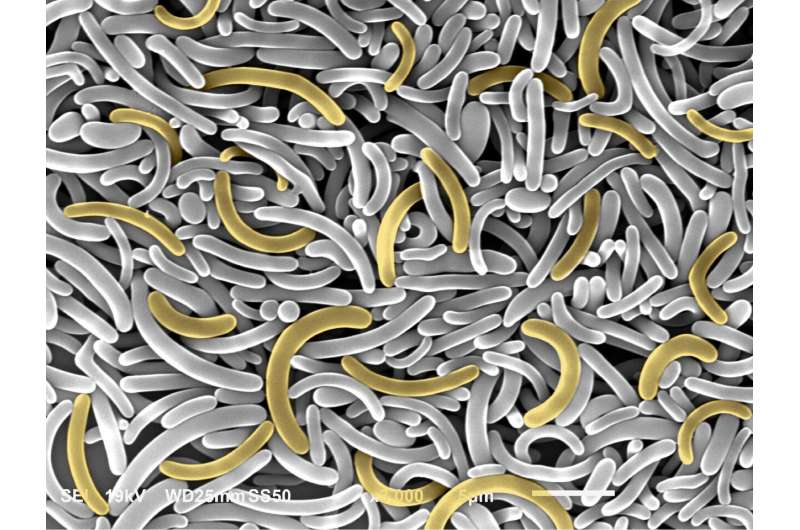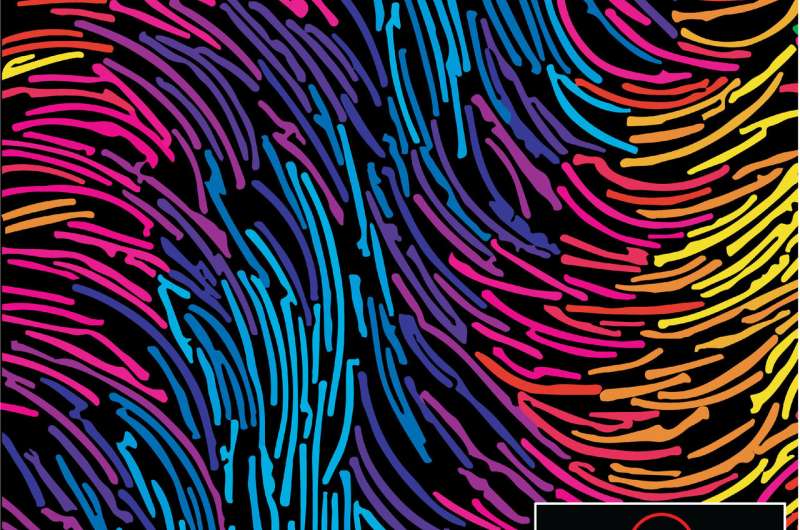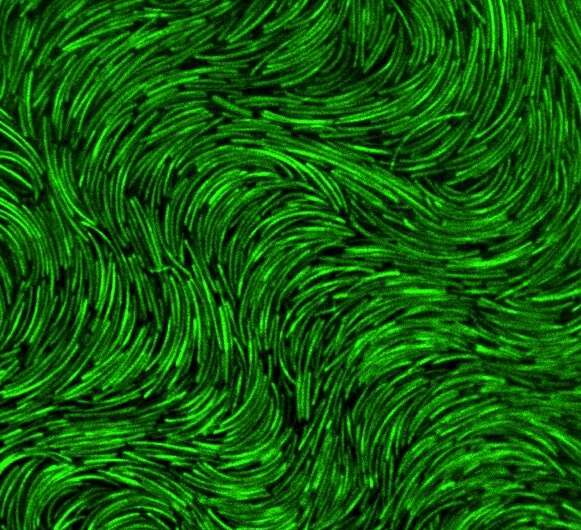Scanning electron microscopy image of the colloidal bananas. Note the false coloring emphasizes the shape of the particles. The scale bar is 5 micrometers. Credit: Carla Fernandez-Rico
A team of researchers from the University of Oxford and Utrecht University has developed a way to change the curvature of bent molecules using a polymer and ultraviolet light. In their paper published in the journal Science, the group describes their process and possible uses for it. Maria Helena Godinho, with University NOVA of Lisbon, has published a Perspective piece in the same journal issue outlining the benefits of using curved elongated rods (molecules), also referred to as bent-core or banana-shaped molecules, when making chiral liquid crystalline phases—and also outlines the work done by the team in this new effort.
As the researchers note, molecular chirality (when a molecule cannot be superimposed on its mirror image) is generally needed when making chiral liquid crystalline phases—but sometimes, another approach is possible—using curved, elongated molecules that resemble a banana or that have a bent core shape. In this new effort, the researchers have come up with a way to control the degree of bentness in such molecules using a photoresponsive polymer and ultraviolet light. They also found that understanding the building blocks of materials that led to curvature during self-assembly of the molecules was key to learning how to make them bend in desired ways.
The work involved starting with molecules of SU-8 photoresist with no curvature, and then using the heat generated from an ultraviolet lamp to incite bending due to buckling. In so doing, they found that they could intentionally change the curvature of the rods by monitoring their progress with confocal microscopy. As part of their work, they found that they were able to induce a wide range of phase behavior in the rods, such as smectic-like phases (both polar and antipolar) and biaxial nematic phases. They also found that they were able to incite a splay-bend-type nematic phase, a rare accomplishment in the lab. The net result, as Godinho notes, is that the work has opened the door to the production of a new range of nematic colloidal liquid crystals, which are, of course, used in a wide variety of displays in electronic devices.
Confocal microscopy movie of the deformation of straight rods into colloidal bananas a heating process at 95 °C. Credit: Carla Fernandez-Rico
Confocal microscopy movie of how the colloidal bananas move when forming the splay-bend nematic phase. Credit: Carla Fernandez-Rico
Bright-field microscopy movie of the colloidal bananas freely moving in water. Credit: Carla Fernandez-Rico
-
Bananas in the splay-bend nematic phase colored according to the particle orientation as indicated by the white arrows in the inset. Credit: Carla Fernandez-Rico
-
Confocal microscopy image of the splay-bend nematic phase. Note the wavy nature of these phase arises from the banana-shaped of the particles when packing close together. The field of view is 60x90 m2. Credit: Carla Fernandez-Rico
More information: Fernández-Rico et al., Shaping colloidal bananas to reveal biaxial, splay-bend nematic and smectic phases. Science (2020). science.sciencemag.org/cgi/doi … 1126/science.abb4536
Journal information: Science
© 2020 Science X Network


























